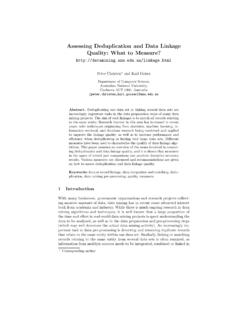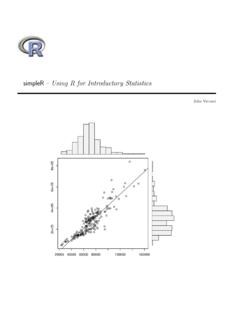Transcription of Metal Detector using a 2 Pulse Induction Coil
1 Department of Engineering A Pulse Induction Metal Detector ENGN3227 Analogue Electronics Dr Salman Durrani Group TA5 James Boxall u2553319 Stephen Purvis u2560946 Garrick Madge u3545631 Tathagat Banerjee u2583957 Group TA5 1 Analogue Electronics - ENGN3227 Table of Contents 3 Project 4 4 5 6 Circuit 6 Schematic and detailed 7 9 10 11 APPENDIX A .. 11 APPENDIX B .. 14 APPENDIX C .. 20 Group TA5 2 Analogue Electronics - ENGN3227 Abstract This project focuses on the adaptation, simulation and construction of a commonly available schematic for a Pulse Induction (PI) Metal Detector . The background information of the history and uses of Metal detectors is presented as well as the design criteria for out particular project. The theory behind how a basic PI Metal Detector works is examined, along with the basic details of a readily available design for a Detector .
2 A detailed examination of the chosen schematics and the function of each component is examined and explained, as well as explanations for certain choices of component values. The results of a computer simulation using Pspice are shown, and then the results of the actual construction of a breadboard prototype, along with the problems encountered are examined. Group TA5 3 Analogue Electronics - ENGN3227 Project Aim The aim of this project was to create a circuit that was capable of detecting Metal . It had to be battery powered and use a commonly available and understood design. In addition to this, the circuit design had to be relatively simple and compact so as to fit on a size limited Printed Circuit Board (PCB) board (due to the use of the EAGLE PCB layout tool). Background A typical Metal Detector used for detecting buried coins, gold, or landmines consists of a circular horizontal coil assembly held just above the ground as shown in the figure to the right.
3 Other uses of more specialized Metal detectors include usage in medicine, security etc. Metal detectors have been used for diagnostic purposes since 1881. They have been utilised to localise a myriad of foreign objects including bullets, intraocular metallic fragments, swallowed coins and other foreign bodies and medical devices. Rapid detection of metallic objects may facilitate diagnosis or treatment. Metal detectors are diagnostically useful because of their low expense, lack of radiation exposure and ease of use1. Other uses include demining (the detection of land mines), the detection of weapons such as knives and guns, especially at airports, geophysical prospecting, archaeology and 'treasure hunting'. Metal detectors are also used to detect foreign bodies in food, and in the construction industry to detect steel reinforcing bars in concrete and pipes and wires buried in walls and floors2.
4 Metal detectors are finding applications all over the place as the ability to detect certain types of materials at a distance become ever more crucial. Figure 1 A typical commercially available Metal detector3 1 Diagnostic uses of Metal detectors: a review - 2 Group TA5 4 Analogue Electronics - ENGN3227 Theory The kind of Metal Detector we have built is based on Pulse Induction (PI). PI systems may use a single coil as both transmitter and receiver, or they may have two or even three coils working together. This type of Metal Detector sends powerful, short bursts (pulses) of current through a coil of wire. Each Pulse generates a brief magnetic field. When the Pulse ends, the magnetic field reverses polarity and collapses very suddenly, resulting in a sharp electrical spike.
5 This spike lasts a few microseconds (millionths of a second) and causes another current to run through the coil. This current is called the reflected Pulse and is extremely short, lasting only about 30 microseconds. Another Pulse is then sent and the process repeats. A typical PI-based Metal Detector sends about 100 pulses per second, but the number can vary greatly based on the manufacturer and model, ranging from a couple of dozen pulses per second to over a thousand. If the Metal Detector is over a Metal object, the Pulse creates an opposite magnetic field in the object. When the Pulse 's magnetic field collapses, causing the reflected Pulse , the magnetic field of the object makes it take longer for the reflected Pulse to completely disappear. This process works something like echoes: If you yell in a room with only a few hard surfaces, you probably hear only a very brief echo, or you may not hear one at all; but if you yell in a room with a lot of hard surfaces, the echo lasts longer.
6 In a PI Metal Detector , the magnetic fields from target objects add their "echo" to the reflected Pulse , making it last a fraction longer than it would without them. A sampling circuit in the Metal Detector is set to monitor the length of the reflected Pulse . By comparing it to the expected length, the circuit can determine if another magnetic field has caused the reflected Pulse to take longer to decay. If the decay of the reflected Pulse takes more than a few microseconds longer than normal, there is probably a Metal object interfering with it. The sampling circuit sends the tiny, weak signals that it monitors to a device call an integrator. The integrator reads the signals from the sampling circuit, amplifying and converting them to direct current (DC). The direct current's voltage is connected to an audio circuit, where it is changed into a tone that the Metal Detector uses to indicate that a target object has been found.
7 PI-based detectors are not very good at discrimination because the reflected Pulse length of various metals is not easily separated. However, they are useful in many situations in which other non PI based Metal detectors would have difficulty, such as in areas that have highly conductive material in the soil or general environment. Also, PI-based systems can often detect Metal much deeper in the ground than other systems3. 3 How Metal Detectors Work - Group TA5 5 Analogue Electronics - ENGN3227 Implementation Circuit Choice As described earlier, the basic design of this Metal Detector is a Pulse Induction (PI) design. Although multiple coils can be used for a PI Metal Detector , the system chosen for this group was a single coil design, for simplicity in design and construction.
8 The circuit design was taken from the Chemelec4 website which contained schematics and construction notes for both one and two coil Metal detectors. The one coil design that has been used for this project is known as the Pulse 1 Metal Detector . The circuit was chosen for its learning value and deemed complex enough to mitigate a complete design from scratch. It involved considerable study to understand the components used and how they interacted. The procurement was lengthy and difficult. The wide range of devices challenged construction including a surface mounted device. Not all parts were available due to cost and availability and minor modifications were made. This included substitution of resistors, variable resistors and capacitors. The PCB was redesigned and the version on the website was not used. A block diagram of the circuit can be seen in Figure 2.
9 Figure 2 Block Diagram of the Pulse 1 Metal Detector The basic design of the Metal Detector consists of four parts as seen above. These are: The power supply (four IC s), The Pulse generation circuit (four 555 s, and coil), The detection system (coil, amplifier and integrator), and The instrumentation system (555). The Pulse generation system provides a continuous train of pulses with a specified frequency, width, time for the back EMF to decay and time for the system to listen for any induced signals in a target. These can be changed by adjusting the capacitors and 4 Group TA5 6 Analogue Electronics - ENGN3227 resistors around the integrated circuits used. A transistor acts as a switch changing the mode of the coil from generating signals to listening for signals.
10 The detection system then amplifies any signal detected and turns it into a continuous and stable voltage that increases a slow and steady beat heard in a speaker. Another switch ensures that the signal amplifier has no output whilst the coil is generating signals. This alerts the operator to any target metals. Batteries are used for the power supply and other integrated circuits make sure that a steady voltage is supplied even as the battery is slowly drained down to a certain point. Schematic and detailed description We will now discuss the circuits operation in detail, so as to explain the significance and requirement for each component. The modified circuit schematic used is shown in Figure 3. Figure 3 Schematic of the Pulse 1 Metal Detector Power Supply The power for the Metal Detector was supplied by 12V battery or supply.








